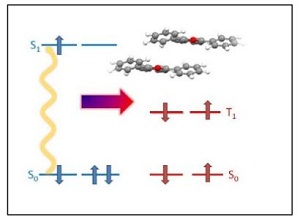New research could dramatically increase PV efficiency
 Photovoltaics could see a 35 percent increase in efficiency through a process called singlet fission. Recently National Renewable Energy Laboratory (NREL) and University of Colorado, Boulder scientists created a molecular system that demonstrates how singlet fission can get two electrons from one photon, thereby increasing the efficiency of photovoltaics.
Photovoltaics could see a 35 percent increase in efficiency through a process called singlet fission. Recently National Renewable Energy Laboratory (NREL) and University of Colorado, Boulder scientists created a molecular system that demonstrates how singlet fission can get two electrons from one photon, thereby increasing the efficiency of photovoltaics.
The development could increase light-harvesting in photovoltaics by 35 percent, according to NREL. The research was published by NREL’s Justin Johnson and Arthur Nozik and the university’s Josef Michl in the Journal of the American Chemical Society.
NREL explained that “in singlet fission, a light-absorbing molecular chromophore shares its energy with a nearby non-excited neighboring molecule to yield a triplet excited state of each.” When the two triplets behave independently, they can generate two electron-hole pairs for each photon that’s absorbed by a solar cell, increasing efficiency.
Still, the technology is far from commercial-ready. Johnson said that more research needs to be done.
“We have demonstrated that singlet fission can be efficient under the right circumstances, but we do not yet know exactly how it happens nor exactly how to harvest the extra electrons that singlet fission produces,” he said. “These types of problems usually get resolved over 5 plus year timeframes.”
Nozik said, “The reported advance is a basic scientific one, and it will take a lot of applied research to utilize this effect in a commercial solar cell.”
Singlet-fission compounds will be applicable to traditional photovoltaics, but an upgrade to the existing technology wouldn’t hurt.
“There are some schemes in which the device will be designed differently in order to take full advantage of singlet fission,” explained Johnson.
The theoretical 35 percent increase is for an idealized solar cell operating at the thermodynamic limit without singlet fission, Johnson said.
“In that case, a 32 percent solar cell would increase to 44 percent with an added singlet fission layer,” he said. “No single-junction solar cells actually operate at this limit, so it is not very practical, but it is a good reference point for demonstrating the expected gain.”
He added that less-efficient solar technologies, like organic photovoltaics, would see a much larger gain in efficiency.
Pictured: "Depiction of the singlet fission process by which a single absorbed photon creates an excited singlet state that evolves into two triplet states. Electron transfer can then occur from the two triplet states to produce two electrons per absorbed photon in a solar cell device" (Johnson et al., 2010). Image courtesy of Johnson et al.



